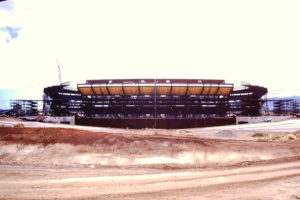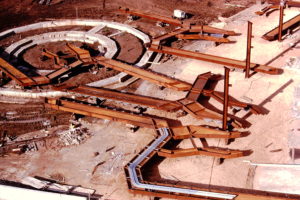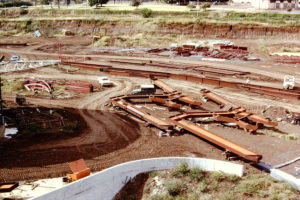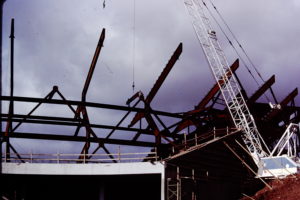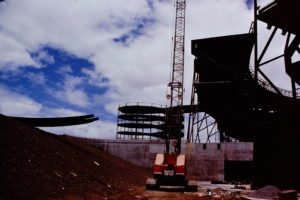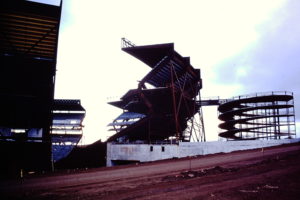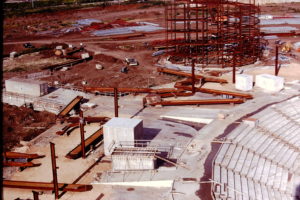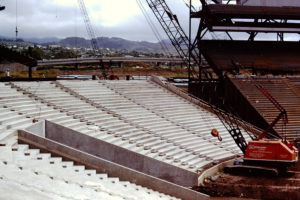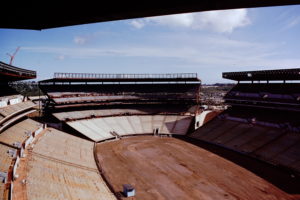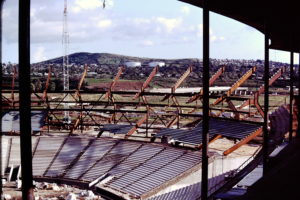About
The New Aloha Stadium Entertainment District (NASED) project aims to create an exciting and vibrant new Aloha Stadium and surrounding district. This ambitious endeavor involves designing, constructing, operating, and maintaining the new stadium while also dismantling the existing one and revitalizing that area of the site. To make this project possible, the State of Hawai‘i will collaborate with a private developer to develop and deliver both the new Aloha Stadium and surrounding site, as one integrated public-private partnership (P3) project. The selection process for the developer involves three (3) stages: the Qualifications Phase, followed by the Proposals Phase, and concluding with the Diligence and Discussion Phase.
One of the key advantages of the P3 arrangement is that the selected developer will be responsible for maintaining the facility and the surrounding district. This proactive approach ensures that the stadium and district will be well-maintained and free from the deferred maintenance issues experienced in the past. At the end of the stadium’s 30-year maintenance term, the stadium will be returned to the state in good working condition.
The new Aloha Stadium will have a seating capacity of 22,500, compared to the previous 50,000 seats. It will be designed to accommodate various sports and entertainment events, such as football, soccer, rugby, and others played on a rectangular field. The multi-purpose stadium will be designed to enhance the fan experience with a comprehensive array of amenities and support spaces to market new events, including various seating options, extensive concessions, and efficient facility circulation.
NASED will include delivery of an integrated, mixed-use, live-work-play-thrive district anchored by the new Aloha Stadium. Development of the surrounding district is expected to occur over 20+ years and include residential market and housing options, hotels, office, retail, commercial, and entertainment uses in a manner that supports the NASED vision and objectives and will generate annual revenue to the state to help offset the cost of the new Aloha Stadium.
Schedule
STADIUM DISMATLING
Q4 2025
STADIUM CONSTRUCTION
Q1 2026
STADIUM OPENING
Q1 2029
DISTRICT CONSTRUCTION
Approx. 30 years
Background
Existing Stadium Condition
The NASED project was initiated in response to the long-documented challenges the existing Aloha Stadium has been managing regarding corrosion and structural integrity, technical obsolescence and general operational efficiency.
Previous studies commissioned by the Department of Accounting & General Services (DAGS) to assist the State of Hawai‘i documented the existing Aloha Stadium exhibiting signs of aging, code non-compliance, and amenity deficiencies. Updated structural studies concluded the stadium (in 2017) required approximately $300 million in critical health and safety repairs, and an additional $121 million to bring the stadium up to ADA standards and code compliance (in 2017 dollars): “While serving the state and community for the past 44 years, the existing Aloha Stadium is well beyond its practical life as a multi-purpose stadium and requires considerable ongoing investment to keep it in working order, accessible to all users, and safe for the public.”
The culmination of the corrosion and other maintenance issues led the Stadium Authority to cease public events in the stadium’s seating bowl in 2021, effectively requiring that its key tenant, the University of Hawai‘i, find a different home venue until the new Aloha Stadium is complete.
A new stadium on the Hālawa site will eliminate the deficiencies inherent with the existing facility while providing the community with a much-needed, modern, multi-purpose sports and entertainment venue for many years to come. Additionally, a new stadium would be an improvement over a renovated existing stadium at a lower cost and would be the catalyst for over 4 million square feet of ancillary development over a 20+ year period.
As time marches on, the degradation of the building continues, leading the state to undertake an aggressive schedule to mitigate any further issues with this existing facility.
Construction Markets
All major projects must wrestle with market factors and influences from commodities fluctuations, labor costs, and even trade tariffs. Collectively, this is accounted for as ‘escalation’ costs, which means the actual cost of construction goes up every year, depending on the specific market conditions. Late 2021 and early 2022 saw significant construction escalation across all regions, and Hawai‘i was not immune, experiencing construction escalation of 20-30%. While escalation has abated, the ongoing effects of this period continue to impact the project.
Given the fixed state funding, time is of the essence, as any delays to the procurement process will mean that less scope will be afforded and included in the new Aloha Stadium.
Timeframe of Development
The surrounding district developments are expected to be built out over time to respond to market demands. While the idea of fully building out NASED over 5 to 10 years may be attractive from a site and revenue perspective, there is likely not enough demand to support that approach. The best long-term value for the State of Hawai‘i and NASED, as a district, is expected to come from a longer-term build out.
Site Operations and Event
Another key driver for how NASED will be developed is the requirement to accommodate successful continued site operations and events, including the Aloha Stadium Swap Meet & Marketplace and car parking for stadium events. The developer (AHDP) is required to ensure that its development plans accommodate these functions, as a minimum.
History

In 1975, when the existing stadium was completed, the state-of-the-art facility was the first of its kind to offer four (4) movable sections. The 50,000 seat stadium could be configured to offer multiple seating arrangements and field formations that accommodated football, soccer, baseball, and special concert events. It hasn’t been just the stadium though, the site has been extensively used and its home to many iconic events and uses, including the Aloha Stadium Swap Meet & Marketplace and the 50th State Fair. Here are just some of our event highlights over the last forty years.
- 1970
- 1980
- 1990
- 2000
The 70’s
- September 1975 – Crowd of 32,247 come to support UH against Texas A&I for the stadium’s first season opener.
- April 1976 – The Hawaiians play Jacksonville in the very first professional football game.Soccer star Pele and New York Cosmos lure 21, 705 for victory over Team Japan.
- August 21, 1976 – The first NFL Exhibition Game featuring San Fran 49ers defeat San Diego Chargers 17-16 before a crowd of 36,364 fans.
- 1976 – The Honolulu Jaycees bring the 50th State Fair to the stadium.
- December 1976 – Kalapana and C & K end the year with a great concert.
- 1977 – Team Hawaii joins the North American Soccer League and makes Aloha Stadium it’s home.
- December 1978 – First sellout crowd of 48,767 watches eventual national champion University of Southern Cal beat UH 21-5.
- May 1979 – 18,348 fans come out to support UH’s Derek Tatsuno as he strikes out 12 in 11-1 UH victory over Nevada Las Vegas.
- Summer 1979 – The Aloha Flea Market opens and becomes the largest operation of its kind in the state. Highlighting Concerts: Chicago, Santana, Boston, C& K, The Beach Boys, Heart, Eagles
The 80’s
- January 1980 – First of 34 Pro Bowl games announced crowd of 49,800 (10th annual ProBowl)
- November 1980 – The Oahu Prep Bowl game between Iolani and Waianae draws 31,484 the largest crowd to watch high school football game in Hawaii.
- March 1981 – Andy Ganigan scores third round TKO over Manuel Abedoy in co-main event of CBS nationally televised boxing card
- November 1982 – Stevie Wonder concert
- December 1982 – Aloha Bowl debuts with Washington in a 21-20 victory over Maryland
- February 1984 – The Police hold their farewell concert with over 31,000 fans making this one of the largest concert crowds ever at Aloha Stadium.
- December 1984 – A truck and tractor pull event, the Hawaii Super Pull makes it’s debut becoming an instant hit.
- March 1985 – Olympian Duncan Macdonald wins first Great Aloha Run
- 1985 – Superbog Mudracing comes to the stadium
- July 1986 – Frank Sinatra concert draws more than 25,000
- August 1987 – Hawaii Islanders play final season in stadium before moving to Colorado Springs, Colo
- June 1989 – Robbie Knievel crashes in motorcycle event
- August 1989 – Superbowl of Wheels featuring motocycles, cars, bikes and skateboarding holds its inaugural event.
- December 1989 – UH makes first NCAS bowl appearance in 33-13 Aloha Bowl loss to Michigan State
The 90’s
- January 1997 – Michael Jackson plays in back to back sellout concerts
- May 1997 – Whitney Houston Concert
- April 1997 – Sand Diego Padres host regular season series with St. Louis Cardinals that draw 77,432 over two days
- January 1998 – Rolling Stones concert draws more than 55,000
- February 1998 – Mariah Carey ended her Butterfly World Tour
- December 1998 – Air Force defeats Washington 45-25 in inaugural Oahu Bowl game. Game is played two more years before it moves to Seattle
- December 1999 – Saint Louis School defeats Kahuku in first state football championship game
The 2000’s
- 2002 – Janet Jackson’s 2nd concert to the islands, All for You Tour was broadcasted on HBO
- December 2002 – Tulane Defeats UH 36-28 before 35,513 in inaugural Hawaii Bowl
- December 2006 – U2’s final stop on their Vertigo Tour
- November 2007 – Largest UH crowd (49,651) sees Warriors beat Boise State 39-27 for the school’s first out-right conference championship.
- December 2007 – Crowd of 49,566 see UH complete unbeaten (12-0) regular season and clinch the Sugar Bowl berth with comeback victory over Washington 35-28
- January 12, 2008 – Hula Bowl plays its 25th and last game
- February 2008 – Inaugural Pan-Pacific Championship Soccer Tournament
- 2012 – Ziggy Marley Concert
- 2013 – Rugby Team USA vs Samoa
- 2014 – US vs Samoa Rugby League Lava Lava Festival
- 2017 – The Chainsmokers Concert
*all photos courtesy of Alan Straub

